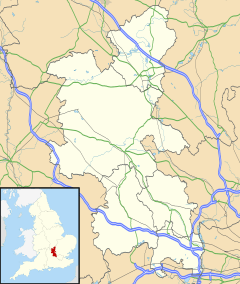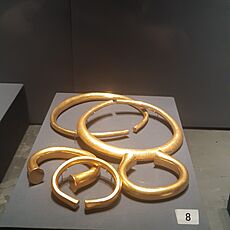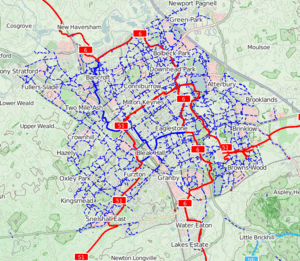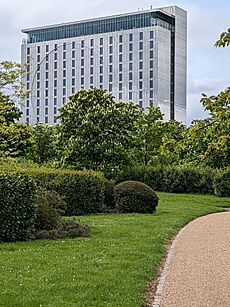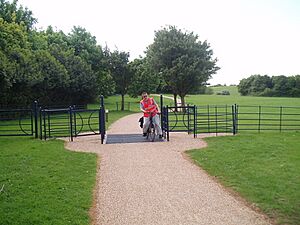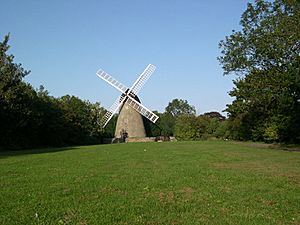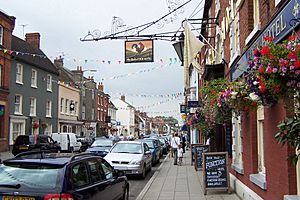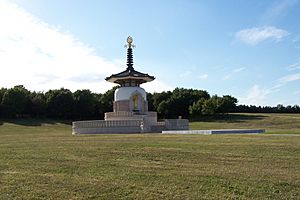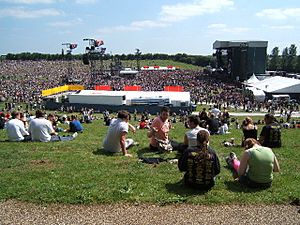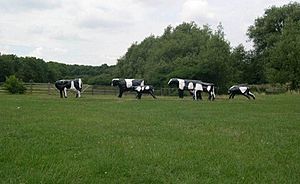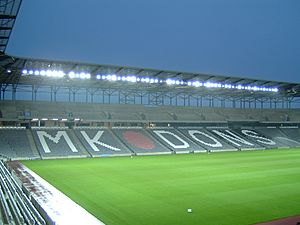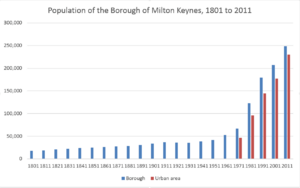Milton Keynes facts for kids
Quick facts for kids Milton Keynes |
|
|---|---|
| City | |
|
|
|
| Area | 89 km2 (34 sq mi) |
| Founded | 23 January 1967 |
| OS grid reference | SP841386 |
| • London | 50 mi (80 km) SSE |
| District |
|
| Unitary authority |
|
| Ceremonial county | |
| Region | |
| Country | England |
| Sovereign state | United Kingdom |
| Post town | MILTON KEYNES |
| Postcode district | MK1–15, MK17, MK19 |
| Dialling code | 01908 |
| Police | Thames Valley |
| Fire | Buckinghamshire |
| Ambulance | South Central |
| EU Parliament | South East England |
| UK Parliament |
|
Milton Keynes (![]() i/kiːnz/ keenz) is a city in Buckinghamshire, England. It is about 50 miles (80 km) north-west of London. In 2021, its main urban area had a population of 264,349 people. The River Great Ouse forms the northern edge of the city. Another river, the River Ouzel, flows through its parks and lakes. About 25% of Milton Keynes is made up of parks and woodlands. It even has two special nature sites called Sites of Special Scientific Interest (SSSIs).
i/kiːnz/ keenz) is a city in Buckinghamshire, England. It is about 50 miles (80 km) north-west of London. In 2021, its main urban area had a population of 264,349 people. The River Great Ouse forms the northern edge of the city. Another river, the River Ouzel, flows through its parks and lakes. About 25% of Milton Keynes is made up of parks and woodlands. It even has two special nature sites called Sites of Special Scientific Interest (SSSIs).
In the 1960s, the government decided to build new towns to help with crowded housing in London. Milton Keynes was planned to be the largest new town. It was designed for 250,000 people and covered a huge area. The plan included existing towns like Bletchley, Fenny Stratford, Wolverton, and Stony Stratford. It also included many villages and farmland. Before building started, archaeologists found signs of people living here since the Neolithic (New Stone Age) period. They even found a collection of Bronze Age gold jewellery called the Milton Keynes Hoard.
The government created the Milton Keynes Development Corporation (MKDC) to design the new city. They wanted a city that felt more natural and human-friendly, but still very modern. To avoid traffic jams, they created a grid of main roads about 1 km apart. The areas between these roads were allowed to grow more naturally. There are also many paths for walking and cycling. Unlike some older new towns, they avoided building tall apartment blocks. Most buildings outside the city centre are no taller than three storeys.
Milton Keynes has many cool places. These include a large theatre, an art gallery, cinemas, a big football stadium, and an indoor ski slope. There are seven railway stations, including one for inter-city trains. The Open University is based here, and there's a campus of the University of Bedfordshire. Many sports are played, and it's home to professional teams like Red Bull Racing (Formula One) and MK Dons (football). The Peace Pagoda at Willen Lake was the first of its kind in Europe. You can also see famous sculptures like the Concrete Cows at the Milton Keynes Museum.
Milton Keynes is a very successful place for business in the UK. Many national and international companies are based here. Most jobs are in service industries, like shops and offices.
Contents
History of Milton Keynes
Why was Milton Keynes built?
In the 1960s, London was getting very crowded. The UK government decided to build new towns to help more people find homes. Some housing for Londoners had already been built in Bletchley since the 1950s. Studies in the 1960s showed that north Buckinghamshire would be a good place for a very large new town, or "new city." This new city would include the existing towns of Bletchley, Stony Stratford, and Wolverton.
The new city was planned to be the biggest yet, aiming for 250,000 people. It covered about 21,883 acres (8,855 hectares). The name 'Milton Keynes' came from a small village already in the area.
How the city was planned
On January 23, 1967, the official order to create the new town was made. At that time, the area was mostly farmland and small villages. The location was chosen because it was roughly the same distance from London, Birmingham, Leicester, Oxford, and Cambridge. The idea was for it to become an important centre on its own.
A special group called the Milton Keynes Development Corporation (MKDC) was put in charge of planning. Before any building began, archaeologists carefully studied every part of the area. This work showed a rich history of people living there since the Stone Age. It gave a unique look into the past of this part of Buckinghamshire.
The MKDC wanted a modern design for the city. They learned from mistakes made in earlier new towns. They created the famous grid roads that run between different areas, called 'grid squares'. They also planned lots of trees, lakes, and parks. Central Milton Keynes (CMK) was designed as a business and shopping area, not a traditional town centre. Each grid square was meant to have its own local shops and facilities. This plan was different from other new towns. It allowed for many types of businesses and homes. Milton Keynes has been very successful and flexible over time.
The government closed down the MKDC in 1992, 25 years after the city was founded. Control then went to other groups, and eventually back to the local council.
Becoming a city
Milton Keynes tried several times to get official "city status." In 2022, during the Queen's Platinum Jubilee celebrations, the area (called the Borough of Milton Keynes) finally succeeded! On August 15, 2022, it was officially announced that Queen Elizabeth II had granted city status. So, while the official status belongs to the wider Borough, people usually call the main urban area "the city."
Where did the name 'Milton Keynes' come from?
The name 'Milton Keynes' was taken from one of the old villages in the area. This village is now often called 'Milton Keynes Village' to avoid confusion. After the Norman Conquest, a family called 'de Cahaignes' (later 'Keynes') owned the land from 1166 to the late 1200s. The village was first called Middeltone, then Middelton Kaynes, and later Milton Keynes.
Milton Keynes' past
The area that became Milton Keynes has a long and interesting history. Even though it was mostly farmland, there's proof of people living here since the Bronze Age. Before building started, archaeologists found many ancient sites. These included places from the Stone Age, Bronze Age, Iron Age, Romano-British, Anglo-Saxon, and Medieval times. There were also newer towns like Wolverton (known for its railway works) and Bletchley (a railway junction).
The most famous discovery was the Milton Keynes Hoard. The British Museum called it "one of the biggest concentrations of Bronze Age gold known from Britain."
Bletchley Park is a very important part of Milton Keynes' recent history. During World War II, it was where Allied code-breakers worked. They broke secret codes, including the German Enigma code. This helped the Allies win the war. It's now a popular place to visit, with hundreds of thousands of visitors every year.
When Milton Keynes was created in 1967, about 40,000 people lived in four towns and fifteen villages in the area.
How Milton Keynes was designed
The unique plan and size of Milton Keynes caught attention around the world. Famous architects like Norman Foster and Ralph Erskine worked on early parts of the city. The Shopping Building is a Grade II listed building, meaning it's historically important. It's seen as one of Britain's best 20th-century shopping buildings.
The Development Corporation also supported a big public art program.
Grid roads and grid squares
The geography of Milton Keynes—the railway line, Watling Street, Grand Union Canal, M1 motorway—sets up a very strong north-south axis. If you've got to build a city between (them), it is very natural to take a pen and draw the rungs of a ladder. Ten miles by six is the size of this city— 22,000 acres. Do you lay it out like an American city, rigid orthogonal from side to side? Being more sensitive in 1966-7, the designers decided that the grid concept should apply but should be a lazy grid following the flow of land, its valleys, its ebbs and flows. That would be nicer to look at, more economical and efficient to build, and would sit more beautifully as a landscape intervention.
The planners of Milton Keynes designed the main roads in a grid pattern. These roads are about 1 km apart. They run between communities, not through them. These main roads are called grid roads. The areas between them are called grid squares. Most grid squares have a local centre with shops and community buildings. Each of the original villages became the heart of its own grid square.
Instead of traffic lights, roundabouts were built at most intersections. This helps traffic flow smoothly. Many grid roads are dual carriageways (two lanes in each direction). The edges of each grid square have lots of trees and plants. This helps reduce traffic noise. Pedestrians usually use underpasses or bridges to cross grid roads safely.
Redways for walking and cycling
Milton Keynes has a separate network of paths for cyclists and pedestrians. These are called the redways. They are about 270 km long. The redways keep walkers and cyclists safe from fast-moving cars. They are usually surfaced with red tarmac. The national Sustrans cycle routes 6 and 51 use parts of this system.
Building heights
The original plan for Milton Keynes said that buildings in the centre should be no taller than six storeys. Houses elsewhere should be no more than three storeys high. People often joked that no building should be "taller than the tallest tree." However, later plans allowed for taller "landmark buildings" in the city centre.
Linear parks
The areas along the River Great Ouse and its smaller rivers (like the River Ouzel) are protected as linear parks. These parks run right through Milton Keynes. They were seen as important for both nature and flood control. These parks cover about 1,650 hectares. This is much larger than London's Hyde Park.
The Grand Union Canal also provides a green route through the city. It's very flat, with only one small lock in its 10-mile journey through Milton Keynes. The first park system was planned by Peter Youngman. He also decided that different areas of the city would have different types of trees and shrubs.
Milton Keynes has more open space per person than any other urban area in the UK. Most of the parks are owned and managed by a charity called the Milton Keynes Parks Trust. This helps make sure the green spaces are looked after, no matter what the council's budget is.
A "forest city"
The original idea for Milton Keynes was to create a "forest city." Millions of trees have been planted over the years. Parks, lakes, and green spaces cover about 25% of Milton Keynes. As of 2018, there are 22 million trees and shrubs in public spaces. The Milton Keynes Parks Trust manages these green areas. The city also has two Sites of Special Scientific Interest, Howe Park Wood and Oxley Mead, which are important for wildlife.
The city centre
Milton Keynes has a special purpose-built city centre. It includes a very large covered shopping centre, a theatre, an art gallery, a cinema, hotels, and a business district. There is also a unique church and the main railway station.
Campbell Park is a beautiful park that stretches east from the business area to the Grand Union Canal. It's considered one of the most imaginative parks built in Britain in the 20th century.
Original towns and villages
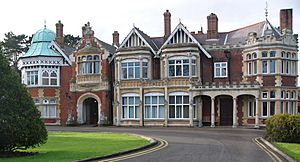
Milton Keynes was built around many older towns and villages. These places became key parts of the new city's design. The main urban area used to be mostly farmland. But it also had many charming villages and hamlets. These included Bradwell, Broughton, Great Linford, Loughton, and Milton Keynes Village. These historic settlements became the focus of their own grid squares.
- Bletchley was first mentioned in the 1100s. Its railway station became an important junction, leading to its growth in the Victorian period.
- Bradwell is an old village with a Norman motte and bailey (a type of castle mound).
- Bradwell Abbey was once an important monastery. Today, only a small medieval chapel and a manor house remain.
- New Bradwell was built for railway workers. A working windmill stands outside the village.
- Great Linford is mentioned in the Domesday Book. Its 17th-century manor house buildings now form an arts centre.
- Milton Keynes (Village) is the original village that gave the new city its name. It still has a traditional pub, village hall, and church.
- Stony Stratford started as a Roman settlement on Watling Street. It has had a market since 1194.
- Walton Hall, the manor house of Walton village, is the headquarters of the Open University.
- The small church in Willen was designed by the famous scientist Robert Hooke. Nearby, there is a Buddhist Temple and a Peace Pagoda, built in 1980.
- Wolverton was a medieval settlement. Modern Wolverton was built in the 1800s for workers at the Wolverton railway works.
Education
Schools in Milton Keynes
When Milton Keynes was planned, schools were carefully included. The idea was for children to walk or cycle to school. Each residential grid square had a primary school (ages 5-8). For every two squares, there was a middle school (ages 8-12). Larger secondary schools (ages 12+) were planned for every eight squares. These secondary schools often shared sports facilities and theatres, which were also open to the public. Over time, some of these plans changed.
Most secondary schools in Milton Keynes are comprehensives. This means they accept students of all abilities.
Universities and colleges
The main office of the Open University is in the Walton Hall area. This university teaches students through distance learning, so most students don't live on campus. Cranfield University, which is for postgraduate students, is nearby. Milton Keynes College offers further education courses. The University of Bedfordshire also has a small campus here.
As of 2023, Milton Keynes is the largest city in the UK without its own traditional university. The council is working to change this. The Open University has announced plans to move its campus closer to the city centre and possibly start teaching full-time undergraduate students.
Milton Keynes also has connections with the University of Buckingham's medical school through Milton Keynes University Hospital.
City history and learning
The Milton Keynes City Discovery Centre at Bradwell Abbey has a large collection of information about how Milton Keynes was planned and built. It also has a library for research. The centre offers educational programs for schools and universities, focusing on the city's geography and history.
Fun things to do
Music and concerts
The National Bowl is a huge outdoor venue that can hold 65,000 people for big concerts and events.
In Wavendon, the Stables is a famous music venue. It was started by jazz musicians Cleo Laine and John Dankworth. It hosts about 400 concerts each year, including jazz, blues, folk, rock, and classical music. It also runs music camps for young musicians. Every two years, the Stables organises the IF Milton Keynes International Festival. This festival puts on shows in unusual places around the city.
The Milton Keynes City Orchestra is a professional orchestra based at Woughton Campus.
Arts, cinema, theatre, and museums
The MK Gallery is a public art gallery that shows international contemporary art. It was updated in 2018/19 and now includes an art-house cinema. There are also two other multiplex cinemas in the city.
The Milton Keynes Theatre opened in 1999 and has 1,400 seats. It has a special ceiling that can be lowered to make the space smaller for different shows. There's another professional performance space in Stantonbury.
Milton Keynes has three museums:
- Bletchley Park: This museum tells the story of wartime code-breaking.
- National Museum of Computing: Next to Bletchley Park, this museum has a working copy of the Colossus computer, the world's first electronic digital computer.
- Milton Keynes Museum: This museum shows what rural life was like before Milton Keynes was built. It also has the British Telecom collection and the original Concrete Cows sculptures.
You can find many other public sculptures around Milton Keynes by artists like Elisabeth Frink and Philip Jackson.
The Milton Keynes Arts Centre offers exhibitions, family workshops, and courses. It is located in the historic buildings of Linford Manor. The Westbury Arts Centre in Shenley Wood is in a 16th-century farmhouse. It provides studios for artists.
Local news and radio
For TV, Milton Keynes is part of BBC East and ITV Anglia. For radio, you can listen to Heart East and local community stations like MKFM. BBC Three Counties Radio is the local BBC station. You can also find CRMK (Cable Radio Milton Keynes) online.
As of September 2021, Milton Keynes has one local newspaper, the Milton Keynes Citizen, which is also available online.
Sports in Milton Keynes
Milton Keynes has professional sports teams:
- Football: The Milton Keynes Dons F.C. play at Stadium MK.
- Ice hockey: The Milton Keynes Lightning play at Planet Ice Milton Keynes.
- Formula One: The Red Bull Racing team is based here.
The Xscape building has an indoor ski slope and an iFLY indoor sky diving facility. The National Badminton Centre in Loughton is where the national badminton team trains.
Many other sports are played at an amateur level. Near the central station, there's a special street skateboarding park called the Buszy. Willen Lake is a popular spot for watersports.
New technologies
Milton Keynes has become a testing ground for new urban technologies. One well-known example is the Starship Technologies' delivery robots. Milton Keynes was the first city in the world to use these robots for urban deliveries in 2018. By 2020, Milton Keynes had the "world's largest autonomous robot fleet." Other projects include the LUTZ Pathfinder pod, a self-driving vehicle.
City services
Hospitals
Milton Keynes University Hospital, in the Eaglestone area, is an NHS general hospital. It has an Accident and Emergency unit. It also works with the University of Buckingham's medical school for teaching. There are two smaller private hospitals as well.
Transport around Milton Keynes
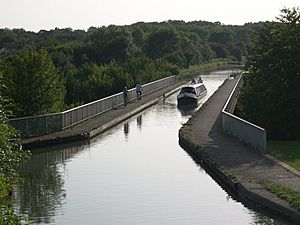
The Grand Union Canal, the West Coast Main Line railway, the A5 road, and the M1 motorway are the main transport routes that shaped the city's design.
Milton Keynes has seven railway stations. Wolverton, Milton Keynes Central, and Bletchley stations are on the West Coast Main Line. Milton Keynes Central has fast trains to London, which take about 35 minutes. Other stations like Fenny Stratford and Woburn Sands are on the line to Bedford.
The M1 motorway runs along the east side of Milton Keynes. The A5 road runs through the west of the city centre. Other main roads connect Milton Keynes to nearby towns like Wellingborough, Kettering, Buckingham, and Bedford. Because it's close to the M1, many large warehouses have been built here, like Magna Park.
Long-distance coaches stop at the Milton Keynes Coachway, which is near Junction 14 of the M1. There's also a park and ride car park there.
Local and regional bus services are run by companies like Stagecoach and Arriva. The City Council also has an on-demand bus service called "MK Connect."
Milton Keynes is part of the National Cycle Network, with routes 6 and 51 using its redway system.
The closest international airport is London Luton, which is easy to reach by coach. Cranfield Airport, a smaller airfield, is about 8 miles away.
People of Milton Keynes
Population growth
In 2011, the population of the Milton Keynes urban area (including Newport Pagnell and Woburn Sands) was 229,941. The total population of the wider borough was 248,800. This is a big increase from about 53,000 people in the same area in 1961. By 2021, the population of the urban area had grown to 264,349, and the borough to 287,060.
Milton Keynes has a younger population compared to many other UK cities. In 2011, about 25% of people were under 18. Also, about 18.5% of residents were born outside the UK. The city is very diverse, with people from many different backgrounds and religions.
Economy and jobs
Milton Keynes is one of the UK's most successful cities economically. It ranks highly for its contribution to the national economy. It also has a high number of new businesses starting up.
Many big national and international companies are based in Milton Keynes. These include Argos, Domino's Pizza, Marshall Amplification, Mercedes-Benz, Suzuki, Volkswagen Group, Red Bull Racing, Network Rail, and Yamaha Music Europe. Santander UK and the Open University are also major employers.
Most businesses in Milton Keynes are small or medium-sized. About 90% of jobs are in service industries, like shops, offices, and healthcare.
Geography and nature
Location and nearby places
Milton Keynes is in south-central England, about 50 miles (80 km) north-west of London.
The nearest larger towns are Northampton, Bedford, Luton, and Aylesbury. The nearest larger cities are Coventry, Leicester, Cambridge, London, and Oxford.
Parks and green spaces
Because of the clay soils and many paved areas, the planners knew they needed to manage water runoff. So, they built two large lakes (Caldecotte and Willen) and many smaller ponds. These lakes are also great places for leisure activities. Building was not allowed in the floodplains of the rivers, which created long linear parks that are easy for most residents to reach.
The north basin of Willen Lake is a bird sanctuary. The two Sites of Special Scientific Interest, Howe Park Wood and Oxley Mead, are very important for wildlife in and around Milton Keynes. Just outside the city is Little Linford Wood, a nature reserve known for its dormice.
Climate
Milton Keynes has a typical oceanic climate for the United Kingdom. This means it has mild winters and cool summers.
The nearest weather station is in Woburn, Bedfordshire. The highest temperature ever recorded there was 39.6°C in July 2022. The lowest was -20.6°C in February 1947.
| Climate data for Woburn, (1991–2020 normals, extremes 1898–present) | |||||||||||||
|---|---|---|---|---|---|---|---|---|---|---|---|---|---|
| Month | Jan | Feb | Mar | Apr | May | Jun | Jul | Aug | Sep | Oct | Nov | Dec | Year |
| Record high °C (°F) | 15.0 (59.0) |
18.9 (66.0) |
22.8 (73.0) |
27.1 (80.8) |
29.4 (84.9) |
33.3 (91.9) |
39.6 (103.3) |
35.5 (95.9) |
32.8 (91.0) |
27.3 (81.1) |
19.4 (66.9) |
16.0 (60.8) |
39.6 (103.3) |
| Mean daily maximum °C (°F) | 7.4 (45.3) |
8.0 (46.4) |
10.6 (51.1) |
13.8 (56.8) |
17.0 (62.6) |
20.0 (68.0) |
22.4 (72.3) |
22.1 (71.8) |
19.0 (66.2) |
14.7 (58.5) |
10.3 (50.5) |
7.7 (45.9) |
14.4 (57.9) |
| Daily mean °C (°F) | 4.5 (40.1) |
4.8 (40.6) |
6.7 (44.1) |
9.0 (48.2) |
11.9 (53.4) |
14.9 (58.8) |
17.2 (63.0) |
17.1 (62.8) |
14.4 (57.9) |
11.0 (51.8) |
7.2 (45.0) |
4.8 (40.6) |
10.3 (50.5) |
| Mean daily minimum °C (°F) | 1.6 (34.9) |
1.5 (34.7) |
2.7 (36.9) |
4.1 (39.4) |
6.8 (44.2) |
9.8 (49.6) |
11.9 (53.4) |
12.0 (53.6) |
9.8 (49.6) |
7.3 (45.1) |
4.1 (39.4) |
1.8 (35.2) |
6.1 (43.0) |
| Record low °C (°F) | −20.0 (−4.0) |
−20.6 (−5.1) |
−15.0 (5.0) |
−7.3 (18.9) |
−5.6 (21.9) |
−1.1 (30.0) |
1.2 (34.2) |
1.7 (35.1) |
−2.8 (27.0) |
−7.8 (18.0) |
−13.9 (7.0) |
−17.4 (0.7) |
−20.6 (−5.1) |
| Average precipitation mm (inches) | 55.4 (2.18) |
44.6 (1.76) |
39.6 (1.56) |
48.3 (1.90) |
51.9 (2.04) |
54.2 (2.13) |
51.2 (2.02) |
58.6 (2.31) |
55.4 (2.18) |
70.7 (2.78) |
64.5 (2.54) |
58.2 (2.29) |
655.3 (25.80) |
| Average precipitation days (≥ 1.0 mm) | 11.7 | 10.0 | 9.3 | 9.7 | 8.7 | 9.2 | 8.5 | 9.4 | 9.1 | 11.0 | 11.7 | 11.5 | 119.7 |
| Mean monthly sunshine hours | 53.0 | 72.3 | 114.9 | 152.2 | 191.5 | 185.7 | 198.4 | 185.3 | 141.6 | 104.5 | 62.0 | 48.3 | 1,509.4 |
| Source 1: Met Office | |||||||||||||
| Source 2: Starlings Roost Weather | |||||||||||||
Famous people from Milton Keynes
Sports stars
- Charles Ademeno, former professional footballer
- Dele Alli, professional footballer
- Andrew Baggaley, English table tennis champion
- Brothers George and Sam Baldock, professional footballers.
- Ben Chilwell, professional footballer
- Chris Clarke, English sprinter
- Lee Hasdell, professional Mixed martial artist and Kickboxer
- James Hildreth, professional cricketer
- Liam Kelly, professional footballer
- Kwame Nkrumah-Acheampong the only Ghanaian winter Olympian.
- Craig Pickering, English sprinter
- Ian Poulter, PGA & European Tour golf professional. Member of the 2010 and 2012 European Ryder Cup Teams
- Mark Randall, professional footballer
- Antonee Robinson, professional footballer
- Greg Rutherford, long jump gold medallist for Team GB at the 2012 Olympic Games
- Ed Slater, professional rugby union player
- Fallon Sherrock, professional darts player.
- Sam Tomkins, professional rugby league player
- Dan Wheldon (1978–2011), Indy car driver
- Leah Williamson, professional footballer
Business leaders
- Jim Marshall (1923–2012), founder of Marshall Amplification (famous for guitar amplifiers) lived and ran his business from Milton Keynes.
- Pete Winkelman, Chairman of Milton Keynes Dons Football Club and owner of Linford Manor recording studios.
Academics and thinkers
- Christopher B-Lynch, a professor who invented a special surgical stitch.
- Alan P. F. Sell (1935–2016), an academic and theologian.
- Alan Turing (1912–1954), a brilliant mathematician who helped create the modern computer. He worked at Bletchley Park.
Stage, screen, and media personalities
- Errol Barnett, a news anchor and correspondent for CNN.
- Emily Bergl, an actress known for her roles in TV shows.
- Emika, born Ema Jolly, a musical artist.
- Richard Macer, a documentary maker.
- Clare Nasir, a meteorologist and TV personality, born in Milton Keynes in 1970.
- Kevin Whately, a professional actor.
Writers
- Sarah Pinborough, an English horror writer.
- Jack Trevor Story, a novelist, lived in Milton Keynes for a long time.
Musicians and bands
Individual musicians
- Bob Leith, drummer for the band Cardiacs.
- Adam Ficek, drummer of the band Babyshambles.
- Gordon Moakes, bassist for the rock band Bloc Party.
Bands from Milton Keynes
- Capdown, a ska punk band, formed in Milton Keynes in 1997.
- Fellsilent, a metal band, formed in Milton Keynes in 2003.
- Tesseract, a djent band, formed in Milton Keynes in 2007.
- Hacktivist, a Grime and djent band.
- RavenEye, a rock band, formed in Milton Keynes in 2014.
See also
 In Spanish: Milton Keynes para niños
In Spanish: Milton Keynes para niños








